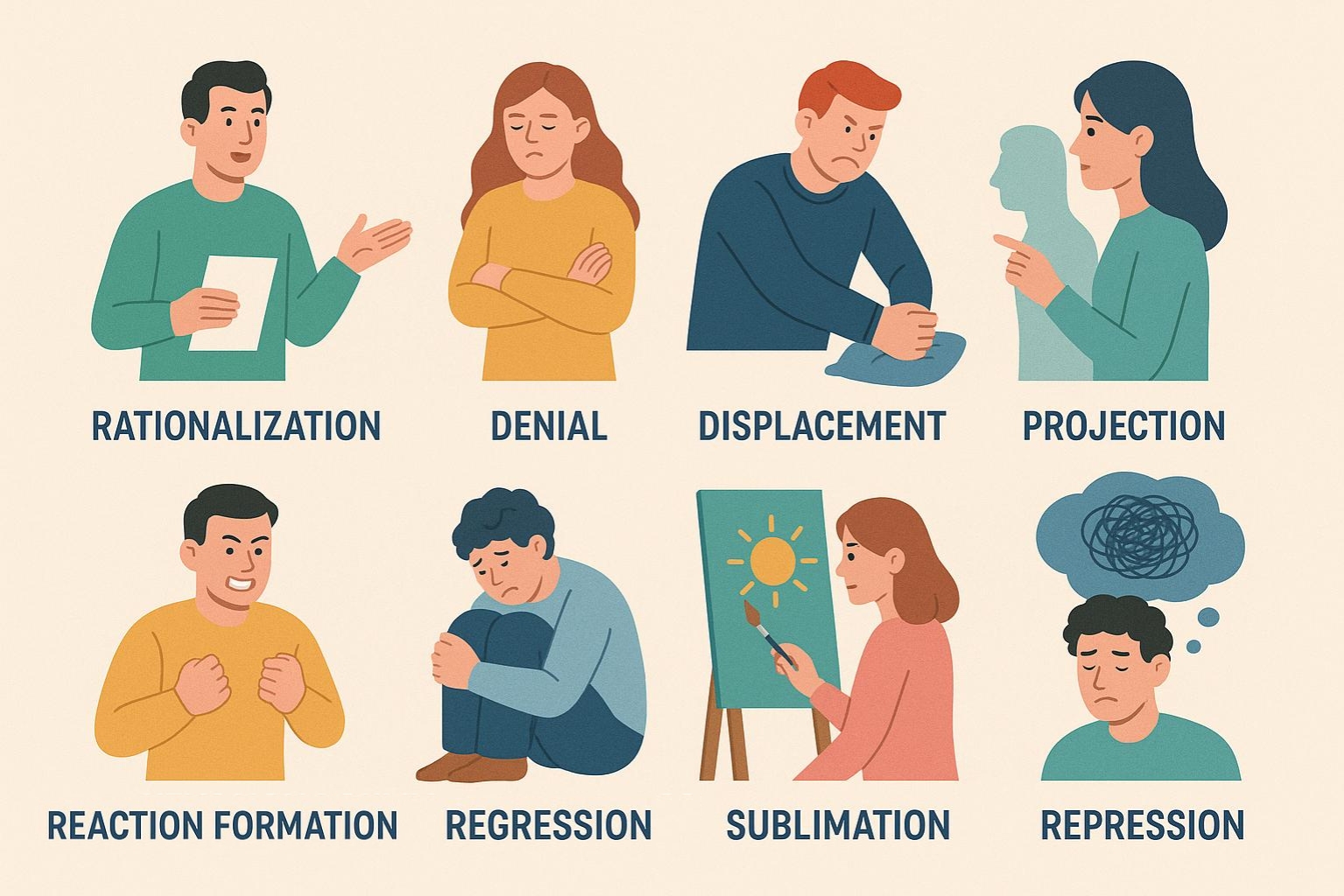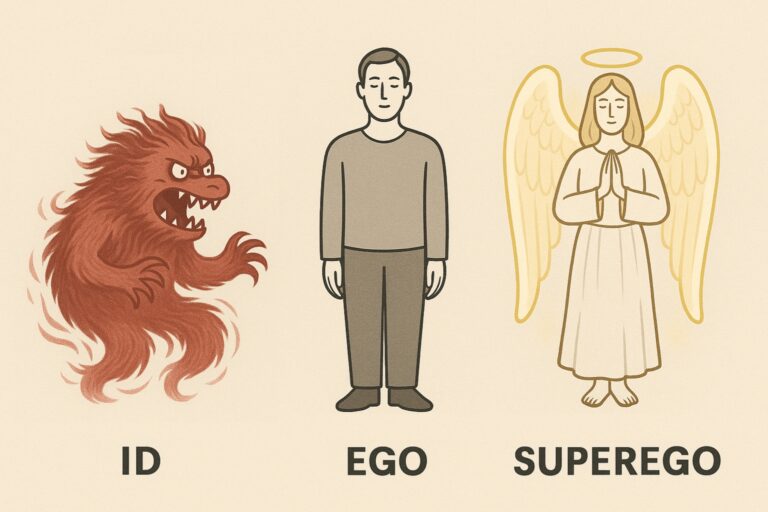Defense Mechanisms: How the Mind Protects Itself

Quick Summary
Defense mechanisms are unconscious psychological strategies that help people deal with difficult emotions, inner conflict, or distressing thoughts. Introduced by Freud, these automatic responses include repression, denial, projection, and sublimation. While they are a normal part of mental life, relying on them too much can lead to unhealthy thinking patterns. Understanding defense mechanisms offers insight into how the mind maintains balance and how self-awareness can support emotional growth.
What Are Defense Mechanisms?
Defense mechanisms are actually very common and part of everyday life. For example, we might say someone is “not ready to face the truth” or “just using a coping mechanism” to get through a tough time. These expressions reflect unconscious strategies the mind uses to protect itself from anxiety, stress, emotional conflict, or distressing thoughts.
These processes operate automatically and work by shaping how we interpret or respond to reality in order to maintain emotional stability.[1] They are a normal part of psychological functioning and often occur without our awareness. The concept was first introduced by Sigmund Freud as part of his psychoanalytic theory.[2]
To understand where defense mechanisms come from, it’s helpful to look at how Freud believed the personality and the mind are organized into three interacting components:
- The id: The source of instinctual drives, impulses, and desires.
- The superego: The internalized sense of morality, rules, and ideals.
- The ego: The rational part that mediates between the id, the superego, and the external world.
When the id pushes for immediate gratification, the superego imposes moral judgment, and reality presents practical consequences, the ego may become overwhelmed. For example, a student might feel tempted to cheat on an exam to get a better grade (id), but also feel guilt and shame at the thought (superego). To ease this inner conflict, the ego may rationalize the decision by thinking, “Everyone cheats anyway.” This self-justification helps override guilt, allowing the student to go through with the act. Defense mechanisms such as rationalization help reduce anxiety and preserve a sense of internal stability.[2]
Freud’s daughter, Anna Freud, later built on these ideas by identifying and classifying specific types of defense mechanisms. Her work helped organize these unconscious strategies into clearer categories, making them easier to observe and understand in both clinical and everyday contexts.[3] Anna Freud’s work helped classify key defenses such as repression, projection, regression, reaction formation, and sublimation. Other mechanisms commonly discussed today, including denial and rationalization, were developed further in later psychoanalytic theory.
These defense mechanisms are unconscious strategies employed by the ego to manage internal conflict and reduce anxiety.
Types of Defense Mechanisms
1) Repression
Repression is the process of pushing distressing thoughts or memories out of conscious awareness. Although forgotten, the repressed material may still influence behavior or emotions.
Example: A person who experienced trauma in early childhood may have no memory of the event but still feels intense anxiety in related situations.
2) Denial
Denial involves rejecting the reality of a situation that is too painful to accept. It can delay emotional processing or decision-making, especially when the truth threatens one’s self-esteem or sense of control.
Example: Someone diagnosed with a terminal illness may insist their test results were incorrect and avoid seeking treatment.
3) Projection
Projection occurs when someone attributes their own unacceptable thoughts or feelings to others. This may serve to protect self-esteem by externalizing feelings that would otherwise cause guilt or shame.
Example: A person who feels jealous might accuse others of being envious of them.
4) Displacement
Displacement means redirecting emotions from the original source to a safer or more acceptable substitute.
Example: A student frustrated with a professor might come home and snap at a sibling.
5) Rationalization
Rationalization involves creating logical explanations to justify behavior that has deeper emotional or unconscious motives. It can help people maintain self-esteem by reframing actions in a more acceptable light.
Example: After getting rejected from a job, someone might say, “I didn’t really want to work there anyway.”
6) Reaction Formation
Reaction formation is behaving in a way that is opposite to one’s true feelings.
Example: A person struggling with low self-esteem might act overly confident or harshly critical to mask feelings of inadequacy and protect their self-image.
7) Regression
Regression is returning to an earlier developmental stage when faced with stress or anxiety.
Example: An adult who is overwhelmed might throw a temper tantrum or seek comfort in childlike ways.
8) Sublimation
Sublimation involves channeling undesirable impulses into acceptable or even productive outlets.
Example: A person with aggressive urges might take up competitive sports or express their feelings through art.
Why Defense Mechanisms Are Important
Psychological Protection
Defense mechanisms act as buffers against overwhelming emotions. They offer temporary relief from anxiety, guilt, or shame and help preserve a person’s self-esteem in the face of internal or external threats.[1] By giving the ego time to process conflict, these strategies protect emotional stability.
Coping with Conflict
When the demands of the id and superego are too intense, defense mechanisms help the ego maintain balance. They allow individuals to navigate inner tensions while continuing to function outwardly.[2]
Adaptive vs. Maladaptive Use
Some defenses, like sublimation, are considered mature and beneficial, while others, like denial or regression, can be harmful if overused. Chronic reliance on immature defenses can prevent personal growth and contribute to psychological issues such as anxiety disorders, avoidance, or relationship problems.[3]
Defense Mechanisms in Modern Therapy
Defense mechanisms remain important in clinical psychology, especially within psychodynamic therapy. Therapists often help clients recognize these unconscious strategies, increase self-awareness, and explore healthier ways to cope. Even in other types of therapy, like cognitive-behavioral therapy, similar patterns are explored using different terms, such as avoidance or unhelpful thinking habits.[4]
Examples of how defense mechanisms may appear in therapy:
- Repression: A client avoids discussing a painful memory and cannot recall key details of the event.
- Denial: A person refuses to accept the seriousness of a health diagnosis despite clear evidence.
- Projection: Someone blames others for feelings they unconsciously experience themselves, like jealousy or anger.
- Rationalization: A student justifies failing a test by blaming the teacher instead of acknowledging poor preparation.
- Displacement: A client who feels powerless at work becomes unusually irritable at home with family members.
By identifying these patterns, therapy can help individuals understand how they cope with stress and guide them toward more adaptive emotional responses.
Criticism and Modern Perspectives
Freud’s theory of defense mechanisms has been criticized for its lack of scientific measurability. Because many defenses operate unconsciously, they are difficult to study with traditional research methods.[2] However, later psychologists such as George Vaillant developed structured ways to observe and classify defenses in clinical populations.[4]
Today, defense mechanisms are still recognized within psychodynamic therapy and are increasingly incorporated into broader models of emotion regulation and coping. Empirical research suggests that individuals who rely on more mature defenses tend to experience better long-term psychological outcomes.[5]
Why It Matters
Defense mechanisms are one of Freud’s most enduring contributions to psychology. They help explain how the mind balances inner tension and protects itself from emotional harm. Although these processes often happen unconsciously, recognizing them is the first step toward greater emotional awareness. Whether it’s repression, projection, or sublimation, these defenses reveal how the mind copes with conflict and how self-awareness can turn those coping patterns into opportunities for growth.
References
- Cramer, P. (2006). Protecting the self: Defense mechanisms in action. Guilford Press.
- Freud, S. (1961). The ego and the id. In J. Strachey (Ed. & Trans.), The standard edition of the complete psychological works of Sigmund Freud (Vol. 19, pp. 12–66). Hogarth Press. (Original work published 1923)
- Freud, A. (1946). The ego and the mechanisms of defence (C. Baines, Trans.). International Universities Press. (Original work published 1936)
- Vaillant, G. E. (1994). Ego mechanisms of defense and personality psychopathology. Journal of Abnormal Psychology, 103(1), 44–50. https://doi.org/10.1037/0021-843X.103.1.44
- Bond, M. (2004). Empirical studies of defense style: Relationships with psychopathology and change. Harvard Review of Psychiatry, 12(5), 263–278. https://doi.org/10.1080/10673220490886167





